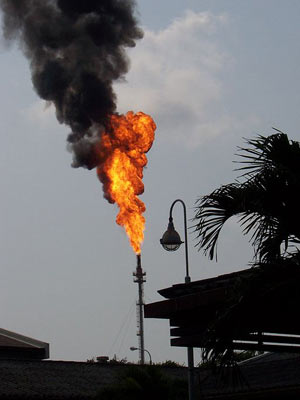The GRI is in the process of finalising a supplement for the Oil & Gas industry.
Many of the participants in this (including serial website award winners Eni and BP) have also taken part in the IPIECA’s guidance for voluntary sustainability reporting, the last update to which came out in December 2010.
What follows is a summary of some of the indicators the guidance recommends and my comments upon them.
However, although these are aimed at the Oil and Gas industry they’re pertinent to many other industries.
Furthermore, as so much of the present economy is founded upon and driven by O&G products, it would do companies outside the industry no harm to have an awareness of these indicators and even discuss how they may be used when making product and supplier decisions.
Environment Indicators
Flared gas has become a hugely controversial subject, not least because of criticisms of Shell in the Niger Delta. There will always be some gas which needs to be burnt off as part of oil drilling safety but, from a sustainability point of view, as much as possible should be captured and sold as part of a location’s overall production.
Alternative energy consumption: a bit like asking turkeys to vote for Christmas, this indicator will probably become more and more widespread as the next few years progress. There is no reason for it to be confined only to the O&G sector.
Ecosystems and fresh water: all extractive industries are, by their very nature, exceptionally dirty industries. There should never be any excuse for damaging an ecosystem or for returning water to the environment in a less pristine condition than it was taken. These are both huge challenges, however reporting just the outputs makes little sense unless the inputs are reported as well.
Health and Safety
Workforce participation can be one of the most controversial aspects of any company’s CSR agenda. The key is to make engagement with the workforce participatory, not consultative: in other words, the workforce’s opinion helps to shape outcome and isn’t just employed to gain buy-in to management decisions. This matters even more in an industry such as O&G which is by its very nature highly distributed and culturally diverse.
Social and Economic Indicators
Local communities, indigenous people, involuntary resettlement and social investment. It’s a long-standing convention that while the people may own the land the state owns the mineral wealth beneath it. However this should not mean that local communities have their land taken away without their consent and their livelihoods ruined. Similarly, if a local community has strongly held cultural beliefs centred upon the land then respecting these has to be given priority.
Too often local communities are ignored, their beliefs belittled and profits from extraction on their land are never seen again. Social investment by the company is one way of mitigating this, but in truth companies need to engage more with the government of the country they’ve partnered with to ensure its activities do not increase these communities’ destitution and exclusion.
Local content, procurement and hiring. Wherever possible all resources, human or otherwise, should be sourced locally. This is a growing trend within O&G and a very welcome one. However it should be given context by a balancing statement of how much the company has brought in from outside the local area.
Transparency is one of the key components to building a true CSR business. There is a difference between commercial confidentiality and secrecy: the former protects an advantage you have within the marketplace, the latter hides a legal or ethical wrong which would damage you if widely known. There therefore has to be transparency in almost all aspects of any business’ operations and management which in turn demands a phenomenal amount of data.
The key advantage websites bring is that they are an excellent repository for this data, making it freely available to anyone who wishes to examine it. It is therefore disappointing that transparency is only mentioned in the Guidance in the context of corruption and making payments to host governments.
Conclusion
These indicators are a valuable set for the O&G industry to follow and many are highly relevant to other extractive and multinational industries.
However there are two issues which are causes for concern: first of all they are called “guidance for sustainability reporting”, yet there is little to do with sustainability within them. CSR (being a responsible business), yes; sustainability (only using those resources a future generation won’t need or which can be replaced), no.
Secondly, while the indicators do much to embed best practice into the O&G sector, there is little there to push it forwards.
That may seem a little churlish of me, but we have to always remember that CSR is not a destination but a journey. As the first hostelry on the road, these (and most likely the GRI ones) make a good first stop. But it’s only a first stop and we cannot allow ourselves to stagnate at this point.
A former CTO, Chris has a broad and varied background. He’s been involved with blue chips, consultancies & SMEs across a wide variety of sectors and has worked in Europe, the Middle East and Australia.
In 2007 he decided to combine his knowledge of business and IT with his passion for all things sustainable and has been busy writing ever since. However, his greatest ambition remains to brew the perfect cup of coffee.
